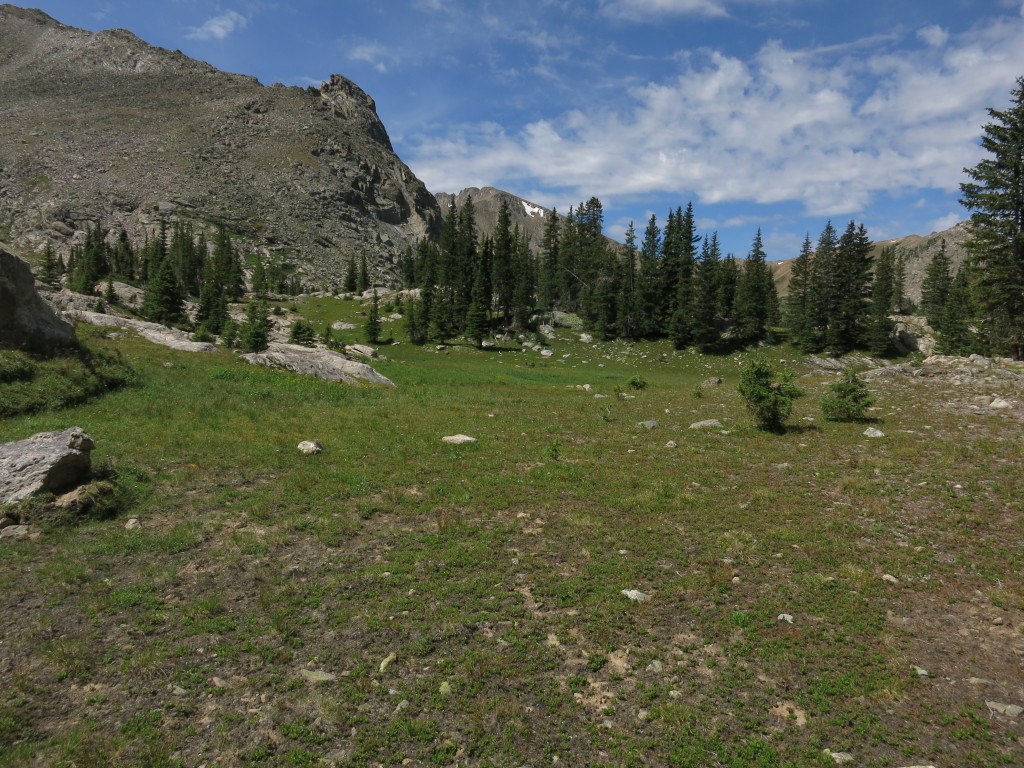The sheer busyness of the 4th of July trailhead outside of Nederland necessitates an early start. Planning on getting 8 miles from the trailhead to make camp also dictates starting early. It all begins at 10,150’ and goes up from there. My desired departure from the trailhead is 5:00am, so that means rolling out of bed at 3:15 or so. I make one large cup of coffee and decide that I’ll eat a pop-tart on the trail for breakfast. A day of high mountain backpacking, exploring and spending the night in the backcountry dictates that calories override a healthy breakfast. And besides, I love pop-tarts!
I’m going solo because Pam’s knee, while better, still isn’t up for a backcountry trip of which a good portion will be comprised of off trail bushwhacking. A couple other friends couldn’t make it either, so with a decent pack load of about 25 pounds I flicked on my headlamp and walked into the dark timber. The skies that created good viewing for the Perseid meteor showers a few nights before meant the forest was pitch black. After 45 minutes or so the stars disappeared and dawn made its presence known.
After three miles I was at Arapahoe pass, 11,900’ high and then went quickly downhill west of the Continental Divide to Caribou Lake. As I passed by the lake at 7:00 I saw a camper standing outside his tent having coffee. I wasn’t close enough to say hello so I made my way along the trail. Shortly thereafter, a small bull elk shot from my left to my right in front of me. I only got a split second glimpse but could see his antlers tilting back from his head as he thundered through the forest. Elk are so large that when they take flight that close to you, you can hear their weight boom against the ground as they run. A quick eight or nine steps was all I heard as he vanished heading east. I couldn’t even locate a track of him where he crossed the trail ahead of me, further building on their ghostly legend.
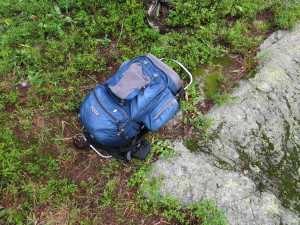
I next came to a large park and took my time crossing here. The trail runs right through the middle of the meadow, so there is no sneaking by unnoticed. A few hundred yards into the meadow and I saw a mule deer doe off toward the east. We looked at each other and she decided she would head back into the timber. The deer in the backcountry act so much differently than deer along the Boulder foothills. Backcountry deer are not used to seeing much human activity and tend to skedaddle when sighted.
Farther along in the park I came across a backpack. I had first seen this backpack five weeks earlier. At the time, it made me very uneasy and I had taken the coordinates and photos and reported it to the police when I walked back out. It was still here now but missing the sleeping bag and sleeping pad. It seemed the backcountry looters were helping themselves. Another unanswered mystery in the wilderness.
At the end of the park it was time for me to get off the trail. This trip was about exploration and getting to know an area better. This would be my third attempt/trip to visit this backcountry basin on the west side of the Continental Divide.
On June 7th, I had done a hike to Arapaho pass looking down to Caribou Lake. I went a short way and sat on a large rocky area surveying the valley below me. It looked like winter at that time. Below is a photo from that hike and there were no footprints or tracks of anybody heading down into the area west of the Continental Divide.
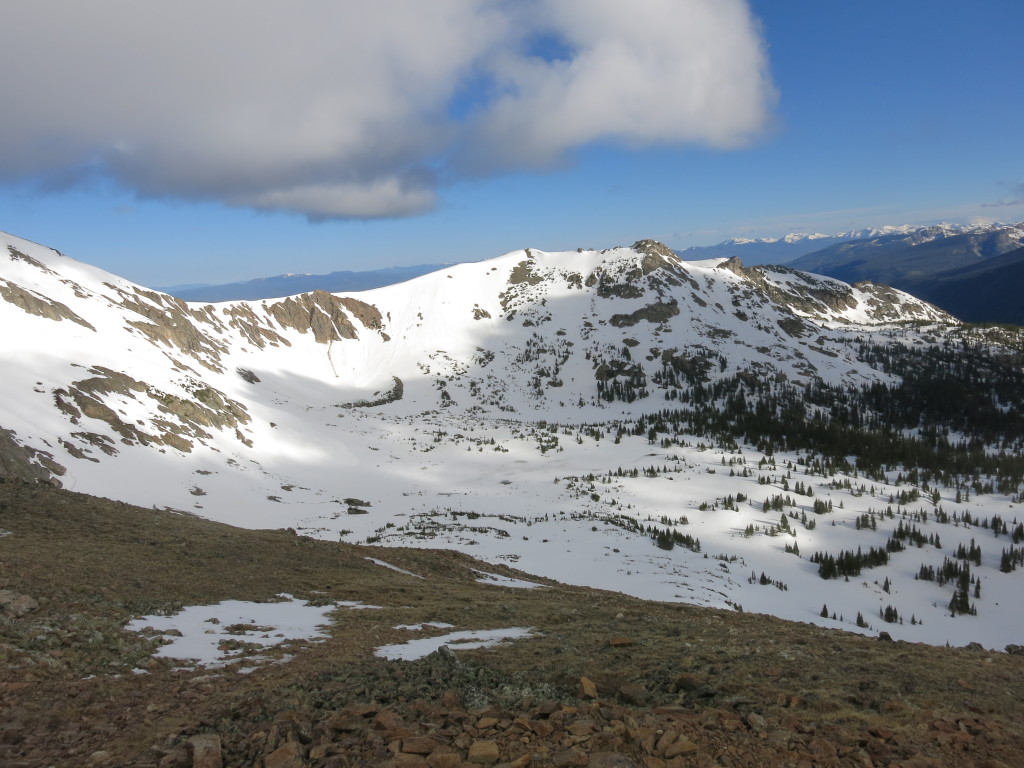
Six weeks later on July 12th I had arranged to meet a buddy at Caribou Lake and camp there with him, his wife and my son, Ben. Ben decided not to go and when I had gotten to Caribou Lake I couldn’t find my friend, who had gone in the evening before. I made a guess as to what had happened and ventured further into the deeper basin for my first look at this area that I had been looking at over the last year on maps. The trip had been incredible, a veritable fairy tale as I entered for the first time. I had seen two large mule deer bucks up high in the basin and had also jumped an elk that I never saw. At noon on that trip I decided not to spend the night feeling certain I would not have slept well not knowing for sure where my friend was. So, I made the long trek back out, sixteen heavy duty miles in my legs and called it training with a full pack on my back. That trip had been extremely wet as the runoff was still in good form. I had to ford creeks a number of times and areas were very marshy. Having soaking wet feet became the order of the day and it was the last trip my Brooks Cascadia 9’s made. I retired them after that trip as they were beginning to come apart.
Having been in and out of the area once before gave me better knowledge about where to cross the creek and then hook into an old trail that an early 1900’s miner had forged in the wilderness to where he had a placer mine. Once I beat through some high flowers and high stepped downed rotting trees I eventually began to see the trail. Old logs that had been cut decades prior confirmed I was on the correct path. I walked the shoulder of the mountain until I came to another creek, again happy to hop across on rocks in lieu of fording since the water had receded. The path then got better and it seemed someone had been through here in the last five weeks. About a mile and half up the path I decided to pitch my tent. I was still almost two miles from the end of the basin but I wanted to see wildlife on this trip and not be camped where they would be disturbed by my presence. I’d come probably a little more than seven miles and it was now 9:30 or so.
After setting the tent, I unloaded some items and shouldered my pack with a rain jacket and things I might need again before coming back to my camp closer to nightfall.
Approaching an open meadow I saw someone had pulled a log across the creek thus confirming the feeling I’d had that someone had visited the area. There are only scant mentions of this area and I think many that end up here are shooting for the higher rocky peaks that encircle the basin. I won’t name the area I was in for a couple of reasons. One is selfish; I found this area via a map and then began searching the internet for others that had been here. I thought about this area for the better part of a year before I successfully entered it the first time. My second reason is safety. Unexplored places are virtually non-existent anymore due to the internet. This presents a variety of problems. People read a person’s account, it sounds exciting and romantic and they take off in pursuit of an adventure. This area is six miles back a trail all above 10,000’ and crossing the Continental Divide at nearly 12,000’. After six miles, it then involves backcountry walking and bushwhacking at times over downed trees, across creeks and back up to 11,000’. This section can be two to three more miles, making it 8-9 miles one way. And then you have to go back! I don’t want to be responsible for someone getting into trouble in the backcountry a long way from help with no cell signal. And the climb back over the Continental Divide involves being in exposed tundra for about a solid hour if you are a fast hiker. It is two hours if you are moving slower at high altitude.
So why do I often go solo? I’ve been going solo into wild areas since I was a teenager. When I was about 20 I would drive three hours from my parents’ home to the mountains of Pennsylvania, hike all day and then often drive home. Or I would spend the night at a hunting camp my father had ownership in. But nobody ever really knew where I was; it was just the way things were back then. Now I take much better precautions. I always leave a map with Pam showing my intended trail and destination. Then I make sure not to deviate from the plan. Additionally I have two or three trusted experienced backcountry friends that know where I am at. If I don’t show up at home or call then Pam knows who to contact. I firmly believe that going alone can be and is very safe. But I don’t want to describe areas where others might get into trouble.
The basin is not very big in the scope of the wilderness. It runs east-west and from the bottom to the cirque at the top of the basin is about two miles as the crow flies and more like three if you can manage as straight a shot as possible. In the last mile at its most magnificent it is only about a quarter mile wide running north-south. To make that quarter mile crossing can take up to half an hour or more in some areas due to the high foliage, downed trees, rock mounds, creek crossing and steep draws on either side. The last time I had been here I had been lucky to stumble onto the deer. But because the only escape route for wildlife is the way they came in, it was necessary for them to sneak past me. Even though the basin is very narrow, it’s a maze of natural obstacles and must be alluring for game. You could be 50 yards from an animal and never see them.
At a certain point I decided to climb high out of the basin so that I wouldn’t disturb the wildlife and I could get a better understanding of the different nooks and crannies of the area. There is something to be said for learning the nuances of smaller backcountry areas. It is one thing to walk on a trail and knock out fifteen miles from point A to point B. But it is a little bit like driving down I-70 of Colorado from Kansas to Utah and never venturing away from the interstate. The views are fantastic and it is strikingly beautiful but you don’t really experience all that it has to offer.
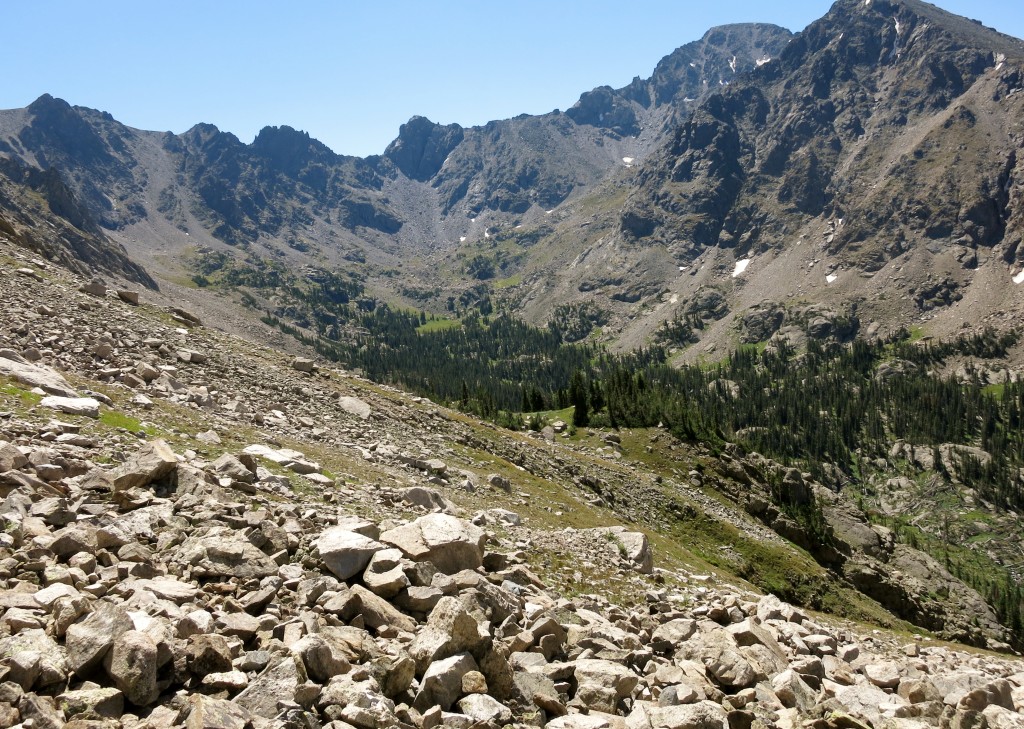
As I climbed up and over rocks, hung on to willows as I stretched to make my next step and moved leaning into the mountain to scale a draw I thought about how many people had actually placed their feet where I had. I like to think not many, but if I could find my way there, then certainly many others before me had as well. Yet, this area is only accessible for a few months out of the year, so I would guess that no more than a dozen people come to this area annually. Maybe I’m wrong, but in two trips I never saw another person up here. I climbed higher until I was tempted to scale and hop across rock fields. But I looked back down to the basin below me and stuck to my plan. I made my way further east and then decided to drop down into the basin proper again.
The whole area took on a different look, a different feel, this time around. When I had come here in July it was sensory overload, the serrated peaks overwhelming me with their stark charcoal color against the brilliant blue skies. The water was flowing strongly and the flowers were superfluous in nature. This time there was a duller edge because I had been here before and also because it was five weeks later in an area that experiences a very short summer. The grasses were more trampled by the wildlife, the beds more numerous indicating the hooved critters that lived here were fairly comfortable just about anywhere.
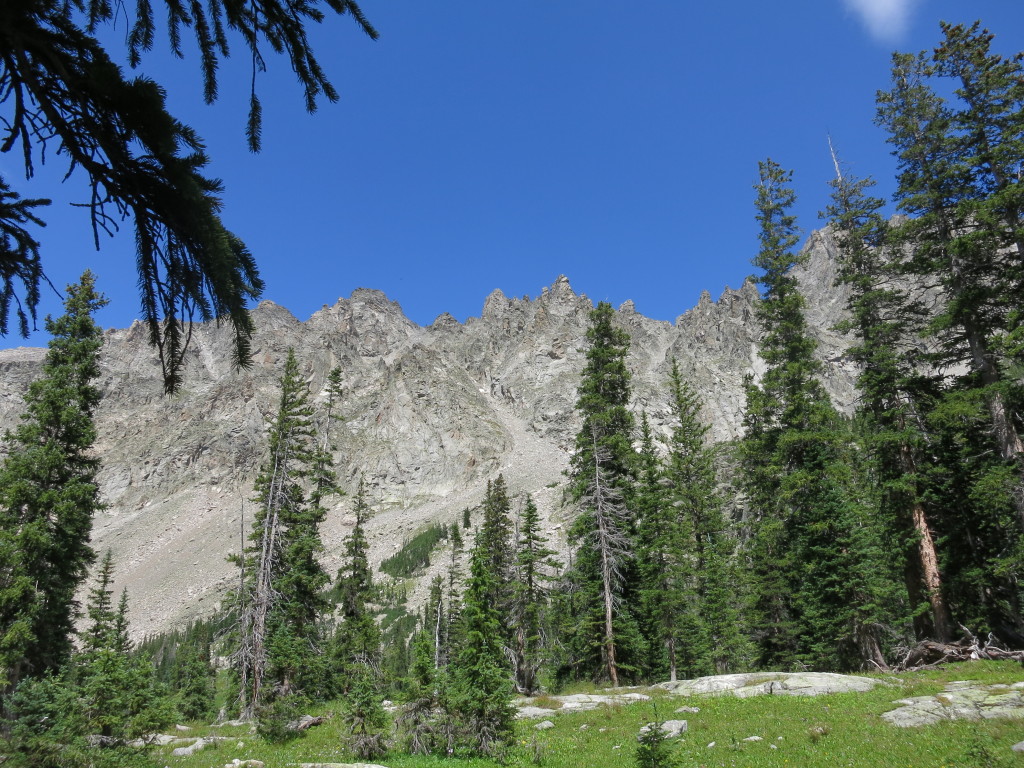
I slowly wound my way over the “sweet potato rows”, small long mounds of earth that were just high enough that you couldn’t see on the other side of them yet couldn’t walk around them, but had to go over them. I came to the south side of the basin and worked east into the deeper draws of the 270 degree cirque. I came upon a small pond that shows on the map and then climbed higher which gave me a beautiful view of a small cascade of water feeding into the basin from up high as I looked south and the last meadow of the basin as I looked north and west.
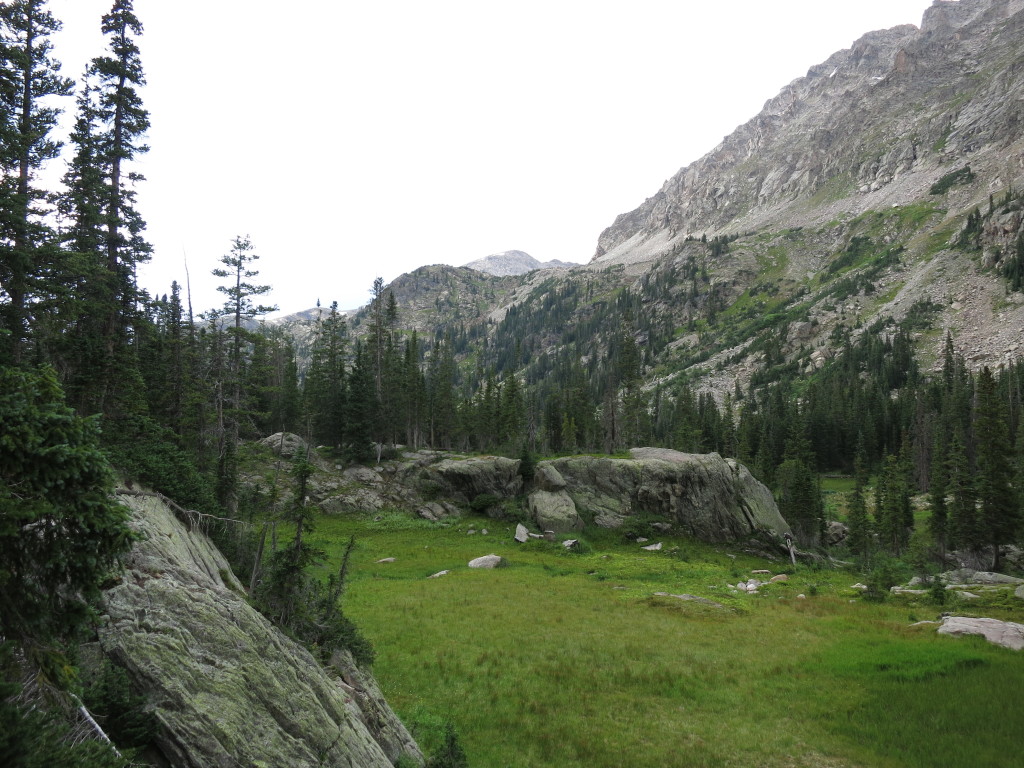
Fatigue set in after an early start and many miles clambering about in God’s country. I lay back on the warm rocks and basked in the afternoon sun. Eventually I made my way down through the big boulders to the basin floor. As I slowly moved west back toward camp I spied the nearly century old cabin built by the old miner. It was nestled inconspicuously amongst the trees, situated just off to the northeast and above a cascade that seemed to split a rock as the water spilled down into the lush green park below. Even here, miles away from another person, with the cabin door barred shut and padlocked, I seemed as if I was intruding into this space. I had read that the forest service had bought the cabin from the miner’s descendants and his 80 acre plot as well. Yellow signs indicated it was now property of the USFS. The fact that it was not vandalized, with all windows intact is a testament to the remoteness of the location. I tried to peer inside and saw that it was littered with items, but not able to make them out because of the haze in the old glass. Again, I felt like I was intruding, so I stepped back for some photos from different angles of the cabin and continued on.
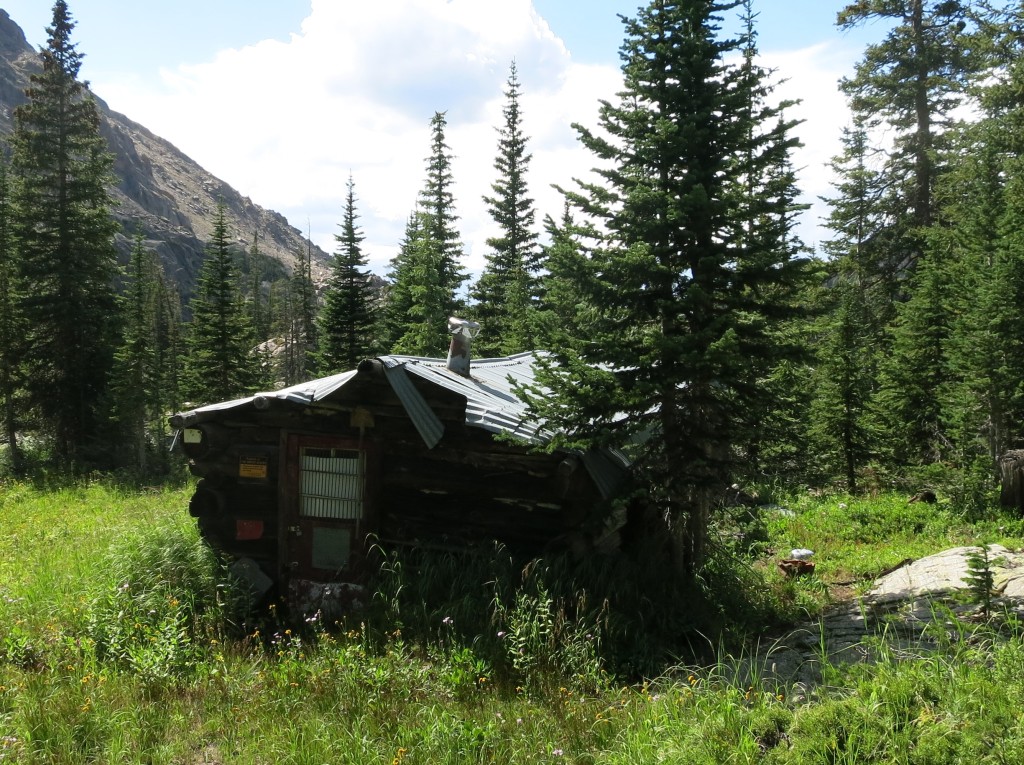
Over the course of the trip I found myself having conversations with the old miner. “What were you thinking when you came here? You must have felt as though you had found a true treasure, or were you so enthralled with the hopes of mineral riches that it was a blur to you? Who helped you blaze these trails back here into the mountains?” And I wonder what he would think of a 50 year old man, with the heart and curiosity of a young teenager who can be so overtaken with such an area and mysterious history.
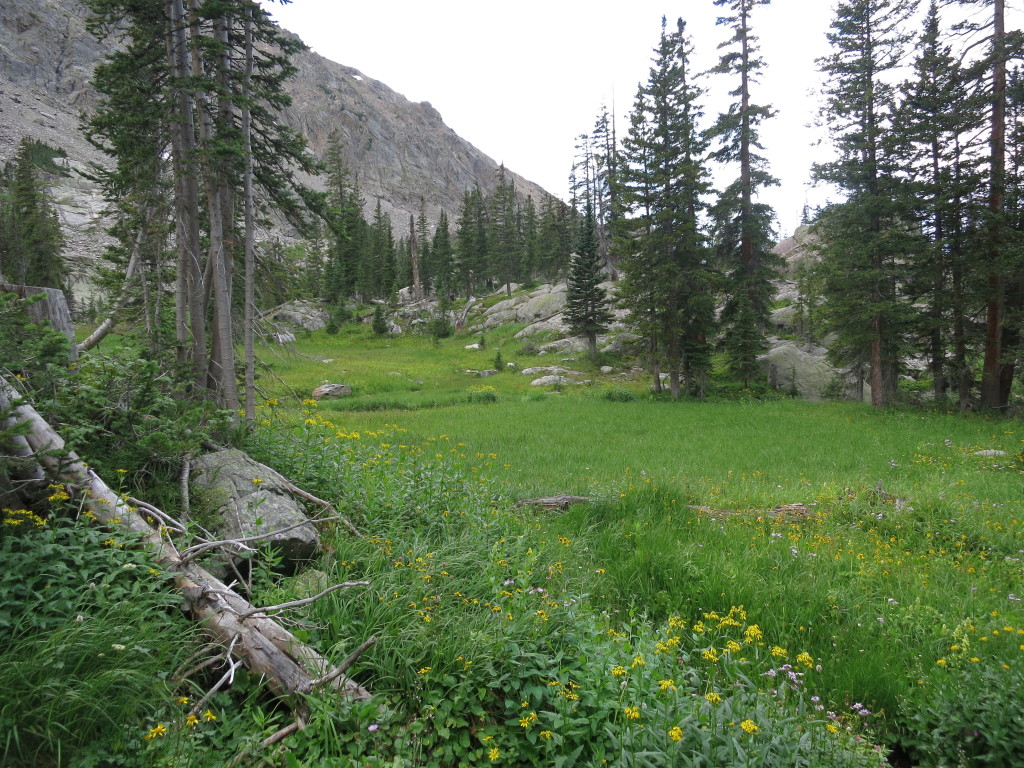
I traipsed back to my tent and made dinner with about an hour of light left. As has been the rule all summer I was sticky with sweat. I was just thinking about washing off after dinner when some raindrops began to fall. Into my tent I went, still so hot at such an altitude that I just lay on top of my sleeping back, stretched my hands behind my head and drifted off to sleep, too tired to read before fading off. It rained hard throughout the night, never developed into a thunderstorm and at some point I pulled the fly back to reveal a sky emblazoned with infinitesimal stars.
Mother Nature awoke me at 5:30 and I crawled straight out of my bag, got dressed and got wet to my crotch heading back into the basin at 6:00. I snuck around for a few hours finding more hidey holes for elk but never seeing the elusive wapiti. By 8:00 I was back having breakfast, a treat of caffeinated instant coffee and had everything packed by 9:00 making my way back down along the old miner’s trail.
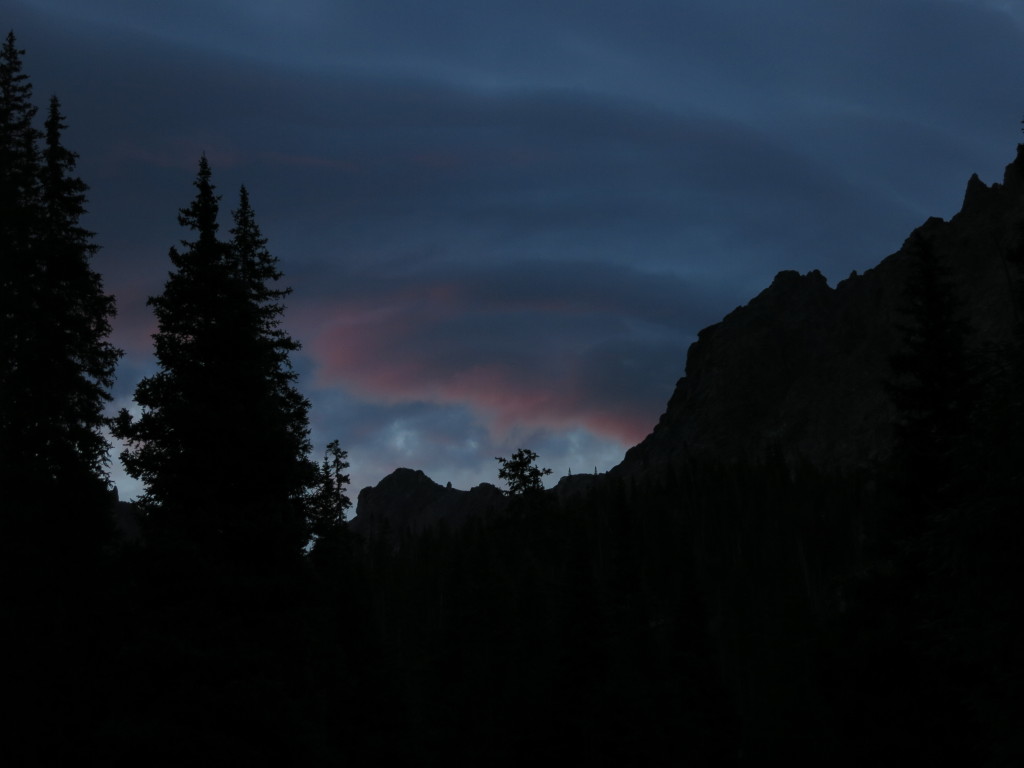
With each step I became more accustomed to the different landmarks and tried to burn them into my memory, knowing that if I make it back here in another month, it will look different again due to fall setting in.
I cross the creek and am back on the “highway” of a trail but after crossing through the park where I had spotted the doe the day before I explore another cirque. Again, it’s a brand new place, a world to explore and get lost in, but lost only in my mind, daydreaming about the life that lives here, the life forms of nature that give such glorious life to a forest wanderer. Vitamin wilderness.
Eventually I come to a bit of a rock overlook after I make a circle back against the moraine. I really want to shortcut back over to Caribou Lake instead of taking the long way back via the trail. I scamper down on some game trails and carefully hopscotch my way across boulders until I get to a steep draw that heads south and up. I check my watch hoping to be at the lake by 1:00, a challenge to open up the lungs a bit and move cross country with no trail and only steep incline. The pitch forces my legs to work hard, my breath expanding my rib cage, a cylinder that holds my lungs as they balloon with air and contract with forced exhalation, a rhythm building as the climb becomes more intense. In surprisingly short order I crest the draw, following a heavy route used by elk to navigate the same route. Now it is an easy walk across soft grasses. I stop to filter some water and make my way to the trail that runs by Caribou Lake. I check my watch. I’ve gotten here well ahead of my estimated time. I’ve seen three people in the last 32 hours. I climb toward the Continental Divide to begin the last four miles back to the car doubling, tripling and quadrupling the number of folks I’ve seen by the time I hit Arapaho Pass. The solitude is over, but the memories will linger for quite some time. Like a seven course dinner, I am satiated and content to head back home.
